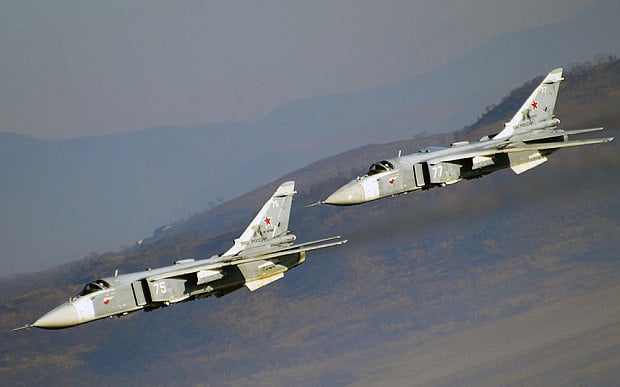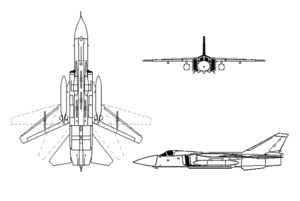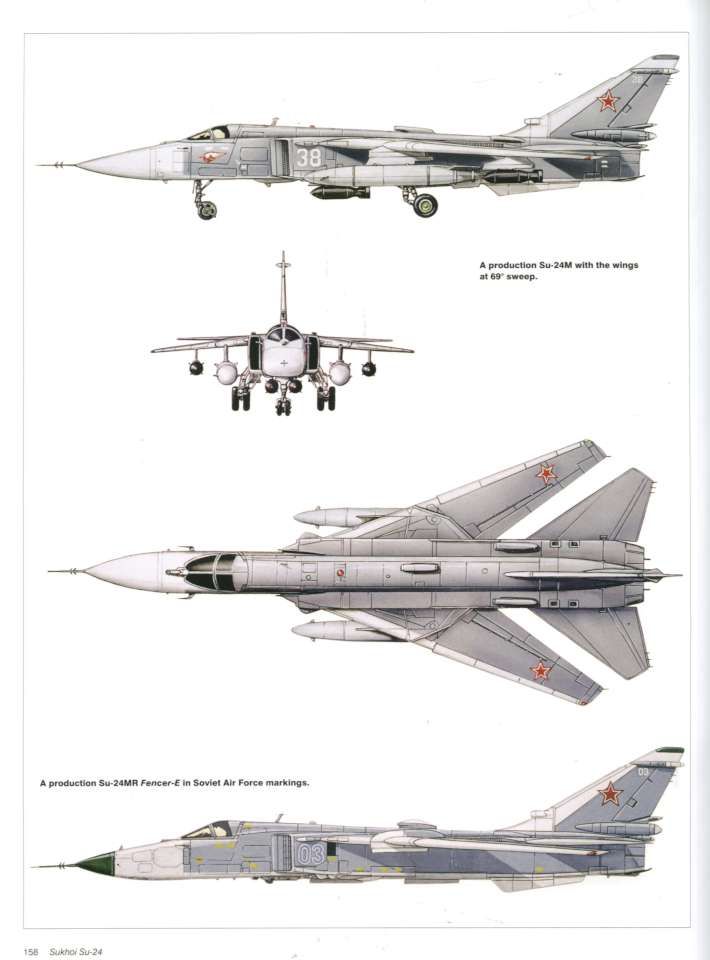
Su-24 ‘Fencer’To fill the requirement for a long range, all weather strike bomber the Soviets developed the Su-24 ‘Fencer’, striking in its similar look and capabilities to the US F-111 ‘Aardvark’. Although both have variable geometry wings, terrain following radar, long range and as side-by-side 2-man crew configuration, the Fencer was never intended to fulfill the strategic bombing role that the Aardvark was designed for. The two aircraft were developed almost in parallel; design was started in the early 1960’s with the F-111 entering service in 1971 and the Su-24 in 1973. Despite the structural similarities to the Aardvark, the Fencer is more on par with the Panavia Tornado in role and capabilities.
Designed to replace the Yak-28 all-weather low level tactical strike bomber, secondary roles were developed as a photo-reconnaissance aircraft and to conduct Electronic Warfare tasks. Able to drop nuclear and a variety of conventional bombs with a high degree of accuracy, Precision Guided Munitions (PGM) capabilities were added later.
Aircraft available to the Soviet forces are somewhat difficult to determine. Please see the notes below to understand how the numbers were derived.

Su-24 ‘Fencer- C’: All original production Su-24s have been upgraded to this standard. About 300 remain in service in the Soviet Air Forces (VVS).
Su-24M ‘Fencer-D’: Significantly improved avionics with a new Terrain Following radar, new inertial navigation system, a mid-air refuelling probe, a laser designator and TV guidance unit for PGMs. About 550 are in service with the VVS while a further 100 serve with Naval Aviation forces.
Su-24MK ‘Fencer-D’: Export version with downgraded avionics and weapons capabilities, not nuclear weapons capable. Various quantities delivered as discussed in the notes below, about 100 (+/- 30) delivered.
Su-24MR ‘Fencer-E’: Reconnaissance version with weapons removed but adding infrared imaging, a TV camera, panoramic film cameras, SLAR (Side Looking Airborne Radar), a SIGINT (Signals Intelligence) pod, and/or a laser scanner pod. This aircraft was equipped with a real time data-link to a ground station for instantaneous passage of images. Self-defence R-60 (AA-8 ‘Aphid’) air to air missiles were the only weapons carried. About 100 were built.
Su-24MP ‘Fencer-F’: Electronic Warfare (EW)/SIGINT and Electronic Countermeasures (ECM) variant. In Northern Fury there are 40 of these important aircraft.
Note: Production numbers are not clear, but considering that this is an alternate history based on reality, some liberties are available. My deductions/assumptions follow:
At least 670 airframes were produced, but probably upwards of 900 to 1200. For Northern Fury we will assume the maximum, as production would have or could have continued past 1991;
About 415 were incorporated into the Russian forces (including 94 to the navy) after dissolution, 120 went to the Ukraine and 38 to Belarus, 12 to Azerbaijan, 25 to Kazakhstan and 32 for Uzbekistan. Assuming that all of these were Su-24M ‘Fencer-D’ versions. That number (642) equates favorably with production quotes of 630, 635, 650 and 670 from various sources. Therefore we will assume that the more often quoted 650 refers to this model only;
Assuming that all ‘MK’ export variants were included in the overall figure, we believe that Algeria received 23 (or perhaps only 16), Angola had 12 (maybe), Iraq had 24 which flew to Iran who acquired another 14 (or 6?), Libya had 6 (or 16), and Syria 22 with possibly another 20: Total = between 74 and 131. Assuming 100 we can reduce the maximum available to the Soviet forced down to ~1100 (from 1200);
Further at least 100 Su-24MR ‘Fencer-E’ were built and 20 Su-24MP ‘Fencer F’ were produced. The low number of ‘MP’ versions is unfortunate as these are very useful aircraft (in the game), and since these are the most advance version their production could continue past 1991 we’ll double that to 40 examples of the EW variant. Therefore our theoretical maximum is now reduced to 960 (1200- 100(MK) -100(MR) -40(MP));
Deducting all of this from the maximum production results in 310 of which we can write off the 10 for accidents and experimental models etc. Therefore 300 Fencer-C airframes are available to the Soviet Air Force (VVS)

